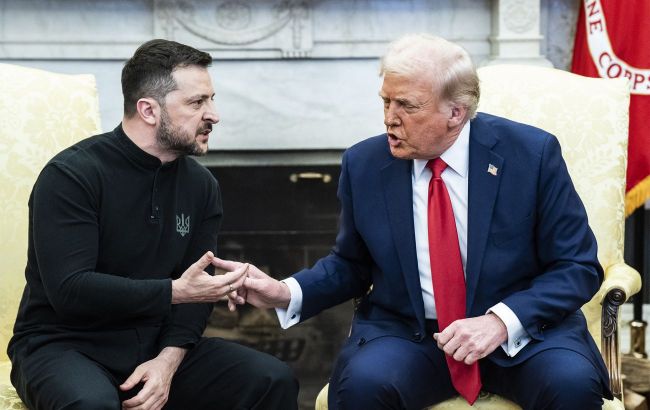Minerals deal with US: What's wrong with Trump's idea and risks for Ukraine
 Donald Trump tightens demands on Ukraine in the mineral resources agreement (Photo: Getty Images)
Donald Trump tightens demands on Ukraine in the mineral resources agreement (Photo: Getty Images)
The US has proposed a new agreement to Ukraine not only about mineral resources but also regarding an investment and development fund. The US continues to exert pressure on Kyiv with the principle of "two steps forward and one step back."
Contents
- What the new agreement with the US entails
- Global reaction to the new US proposals
- Main threats of the new agreement
The United States has offered Ukraine a new minerals deal. It essentially replaces the first draft of the document, which could not be signed in February. However, the content and level of the agreement are significantly different from the previous one.
Previously, it was a memorandum that did not require ratification. Now, it is a substantive document of more than 50 pages, which must be ratified by the Parliament. The full text of the document has not been made public, but the details that have emerged so far have not been denied either in Ukraine or the US.
Deputy Prime Minister Yulia Svyrydenko confirmed that the government received the document from the US, and Kyiv is currently forming its position on the draft agreement. She also noted that any public discussions regarding the agreement only harm and hinder the ability to engage in constructive discussions with American partners. "Once a consensus is reached, we will present a public position," she said.
However, avoiding discussions turned out to be impossible. The content of the agreement is so striking that it immediately caused a reaction both within Ukraine's government and in international media.
Chairman of the Foreign Policy Committee of the Ukrainian Parliament, Oleksandr Merezhko, even has some doubts regarding the document's authenticity. But if it is genuine, he calls it simply absurd. "It seems this is not a fake, because the document is written in the style of American law. But there is no 100% certainty that it is not fake. If this is indeed a serious proposal from the American administration, there are serious problems with the fact that this document is absurd, to say the least," Merezhko noted.
What the new agreement with the US entails
The new draft agreement involves the creation of the American-Ukrainian Reconstruction and Investment Fund, which will be governed by a supervisory board consisting of five members, three of whom will be from the US with full veto power, as noted by Member of Parliament Yaroslav Zhelezniak.
The first project related to rare-earth metals concerned the extraction of uranium, titanium, lithium, graphite, and others. Their deposits are mostly in the Kirovohrad, Zhytomyr, Dnipropetrovsk, and Donetsk regions.
The new agreement will cover not only rare-earth metals but a broader range of minerals. It will address all types of minerals, both those already developed and new ones. "It includes oil, gas, and both new and existing reserves across the entire territory of Ukraine," Zhelezniak said. And this includes not only state-owned minerals. "We are talking about extraction by both state and private companies," the MP emphasized.
The US side of the fund will consist of aid money that the US has provided to Ukraine since 2022. "And they can make a profit based on their decisions. They will receive royalties from the fund first (and then Ukraine) +4%," Zhelezniak added. It should be noted that the exact amount of US aid is still a contentious issue. Donald Trump sometimes mentions $350 billion, while President Volodymyr Zelensky refers to a significantly smaller sum.
The agreement is indefinite and can only be amended or terminated at the initiative of the US. Summarizing the analysis of the draft agreement, Zhelezniak stated that, in effect, the US would receive "first-night rights" to all new infrastructure projects and a veto on the sale of resources.
"This agreement is in the style of conquistadors offering something in exchange for income," commented the Deputy Director of Trade at Dragon Capital, Serhii Fursa, ironically. Considering that the US has not yet increased its support for Ukraine, he believes that signing such a document is not worth it. "The States are not promising us any future aid, so there is no reason to support such extortion," Fursa concluded.
Global reaction to the new US proposals
The Times media outlet suggested that the new agreement is an attempt by US President Donald Trump's administration to gain control over Ukraine's natural resources in exchange for mediation in a ceasefire. The media noted that Ukrainian officials had expressed concerns that such demands could turn the country into a vassal of Washington.
Welt German outlet pointed out that the agreement between the US and Ukraine on resource development has been met with criticism, as some view it as an attempt by the US to treat Ukraine as a vassal state, gaining unfair advantages from the deal. The lack of published details about the agreement, the paper emphasized, has sparked speculation and dissatisfaction regarding the power dynamics and Ukraine's role in the deal. Critics argue that the agreement is economically and politically one-sided and undermines Ukraine's sovereignty.
Financial Times highlighted that the new agreement with the US allows the US to control critical minerals and energy resources in Ukraine without providing any security guarantees.
Experts note that the proposed deal does not include security guarantees from the US, raising concerns that Ukraine may hand over control of its resources without receiving corresponding commitments to protection.
Main threats of the new agreement
Several main threats of the proposed agreement between Ukraine and the United States can already be identified. First and foremost, these are the threats to sovereignty and economic dependence. Such threats are due to the fact that the United States would effectively have full control over the energy and mining sectors. This could lead to increased dependence of Ukraine on external management and limit its ability to independently manage its resources.
The second issue concerns the state budget and unfair profit distribution terms. Revenues from the use of subsoil resources and profits from energy companies have gone and continue to go into the state budget. According to the terms proposed by the United States, these funds would now be directed to the Reconstruction and Investment Fund. These changes will lead to a complete revision of Ukraine's cooperation with the IMF and create budgetary risks.
There is a high likelihood that the US proposal is not the final version of the agreement. The document will be worked on in cooperation with Ukrainian experts, and the quality of its final version will depend on the skill of the negotiators. Meanwhile, the United States is publicly pushing Ukraine. US Secretary of the Treasury Scott Bessent recently stated that the agreement could be signed as early as next week, while Volodymyr Zelenskyy made it clear that it is still too early to talk about signing.
Sources: materials from Western media, statements from Vice Prime Minister and Minister of Economy Yulia Svyrydenko, Chairman of the Verkhovna Rada Committee on Foreign Policy and Interparliamentary Cooperation Oleksandr Merezhko, MP Yaroslav Zhelezniak, and a comment from the Deputy Director for Securities Trading at Dragon Capital, Serhii Fursa.

